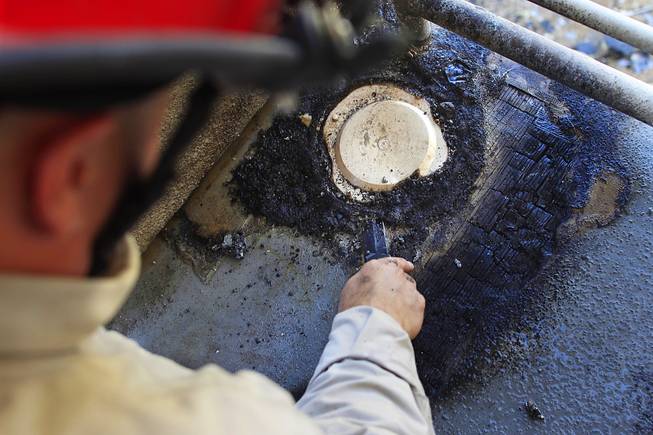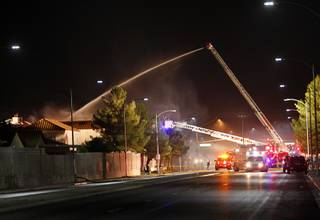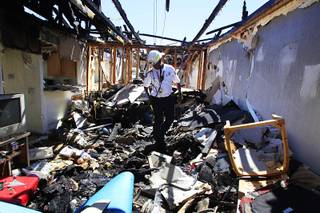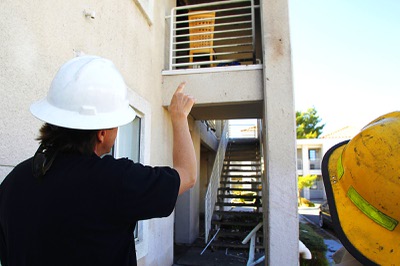
Sam Morris / Las Vegas Sun
A fire investigator digs up melted and charred plastic from an area he suspects was the start of an apartment fire Friday, May 4, 2012.
Wednesday, May 9, 2012 | 2 a.m.
Sun fire coverage
- Fremont Street motel fire sends two to hospital (05-08-2012)
- Woman on oxygen suffers burn while smoking in bed (05-05-2012)
- Golden Nugget fire was arson, investigators say (03-14-2012)
Firefighters in Engine 43 noticed smoke billowing from a nearby northwest valley location as they drove back from another call Thursday evening.
At that point, no one had reported a fire to 911 dispatchers. Instinctively, they headed in the smoke’s direction.
At the corner of Smoke Ranch Road and Jones Boulevard, they found their quarry: smoke was escaping from the eaves of an Ashford Manor apartment building. By then, residents were evacuating and smoke had drifted two miles north to Alexander Road and Rancho Drive.
What started for the responding firefighters as simple smoke in the sky turned into one of the valley’s largest apartment fires in recent months, Las Vegas Fire and Rescue officials said. The attic blaze led to the collapse of the building’s roof and the displacement of 25 residents.
That much was known by 8:30 p.m., two hours after firefighters discovered the blaze. As firefighters continued dousing the building with water, three fire investigators laid the groundwork for an investigation.
“Where did the fire start? How did it start? And the chain of events that led to it starting,” fire investigator David said, explaining the answers he seeks. “We’re still one of the few professions where we give our expert opinion on what started the fire.”
(Fire investigators asked for their last names to be excluded because they do undercover work as part of the county’s bomb squad.)
Thursday night, they began by interviewing residents and talking to firefighters. While the interviews take place, they keep an eye out for physical clues, such as unscathed plastic blinds on the north end of the apartment building.
As residents huddled in the parking lot and anxiously watched firefighters battle the blaze, David gleaned information from as many of those residents as possible — and he tried to offer small bits of reassurance.
“If you tell me exactly where it is and I can get up there, I will,” he told a woman worried about her jewelry in an upstairs unit.
•••
Fire investigators for Las Vegas Fire and Rescue respond to blazes that have reached two-alarm status, injured people, caused more than $50,000 in damage, involved city property or seemed suspicious in nature.
The 10 to 15 investigators on staff (department officials, citing Homeland Security rules, wouldn’t divulge an exact number) average about 275 investigations each year, according to department data. About a third turn out to be arson, said Robert, a senior fire investigator. Accidental and undetermined fires make up the remaining two-thirds, he said.
As of Tuesday, Las Vegas fire investigators had responded to 89 blazes this year. Investigations into those fires have resulted in the arrests of four adults and two juveniles, according to department data.
If the arson is a “spite fire” — meant to harm people or their property — suspects generally make their efforts known to the victims, said Richard, another fire investigator.
“When the bad guys start talking, we start listening,” he said.
Las Vegas fire investigators are considered category one peace officers, which essentially places them on the same platform as police officers with the ability to arrest suspects, Robert said.
“If it’s arson, we’ll handle an investigation from cradle to grave,” including testifying in court after an arrest, he said.
Through the years, Robert said investigators have encountered arsonists who have set fires to appear heroic by saving animals or people. Other serial arsonists derive pleasure from watching property burn, he said.
“A lot of the easier arson fires to prove usually come out of domestic violence,” he said. “People get angry; they get upset. They get very impulsive, so they do stupid things and people will see them do it.”
•••
So what did those plastic blinds have to do with the investigation Thursday night?
They appeared a bit disheveled but otherwise intact, despite visible damage beyond the window frame. Because they hadn’t melted, fire investigators concluded the blaze must have started at the south end of the building and moved north, courtesy of 30-mph winds. Most of the damage on the north end, however, was the result of the roof collapse and water saturation.
“It’s like a big puzzle,” David said.
Fire investigations hearken back to grade-school lessons about the scientific method: gather evidence, examine information, form a hypothesis and test it, he said.
Based on early evidence, investigators ruled out malicious intent Thursday night.
“Right now, everything we’re seeing doesn’t look like an arson,” David said.
A trio of fire investigators returned Friday morning to examine the building in daylight, and immediately, one peculiarity caught David’s attention — burn marks on a railing attached to a second-floor balcony.
“We start (investigating) on the outside and work in,” he said. “We go from the least damage to the most damage.”
As investigators zeroed in on the railing, they found isolated burn marks on the same balcony in a corner next to a stucco-wrapped column. The other balconies did not have those fire patterns.
Inside the adjacent apartment unit, debris from the roof collapse covered the living room, where a television and couch didn’t betray any obvious burn marks. The former attic area was a different story, though.
“Everything that would normally burn in a fire is intact, except for above,” David said.
The previous night, the apartment’s resident admitted to finding a small fire on his balcony, which he thought he extinguished, David said.
In the burn marks on the balcony, fire investigators found remnants of a lighter and the melted remains of what appeared to be a plastic pot.
A hypothesis emerged: The small fire — caused by careless smoking — had not been fully extinguished, allowing the fire to spread inside the column, creating a “chimney effect.” The flames traveled upward, eventually consuming the building’s attic area.
Fire investigators carved into the column, exposing the woodwork inside. On the ground level, the inside looked clean and normal. Upstairs, the woodwork inside the column appeared charred from fire.
Bingo.
“Perfect — just what we expected to see,” said Richard, as he peered into the column above the burn spot on the second-floor balcony.
Fire investigators ruled the blaze accidental, caused by careless smoking. They estimated the large blaze caused $750,000 damage.
“Even though a lot of people lost property, no one is dead. No one is hurt,” said Nick, a fire investigator, as he looked up at the building. “You can replace property.”
With that, contractors moved in to fence off the apartment. Rebuilding awaits.




Join the Discussion:
Check this out for a full explanation of our conversion to the LiveFyre commenting system and instructions on how to sign up for an account.
Full comments policy